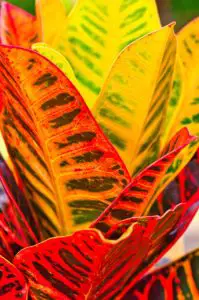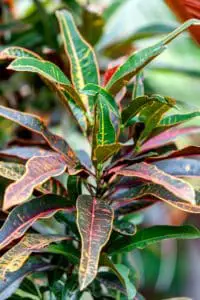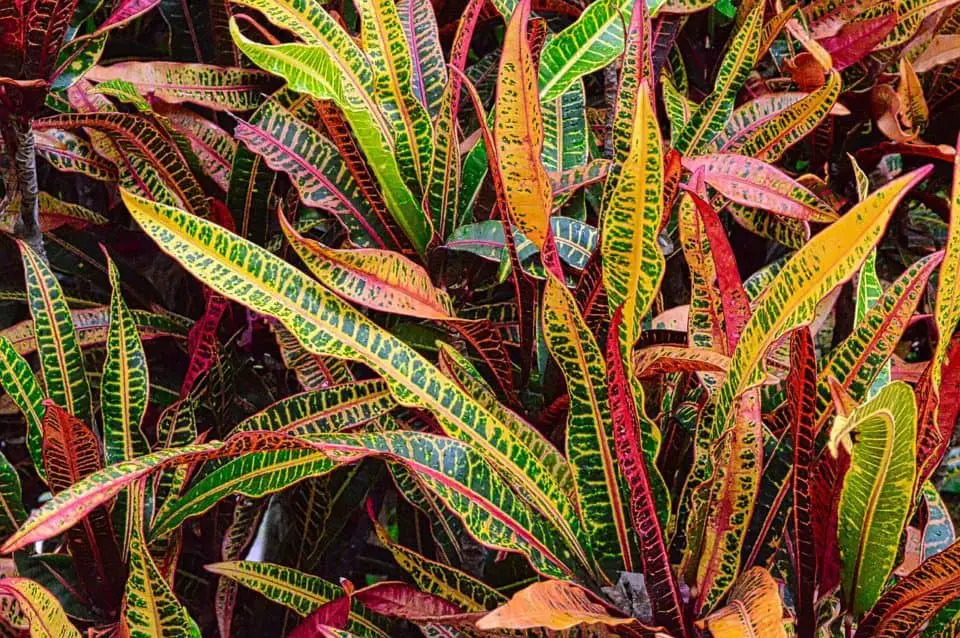Some links in the post are affiliate links and I get a commission from purchases made through some links found in the post.
You may recognise Crotons by the wonderful colours of their leaves, which are often marked with bright reds, oranges, and yellow colourings.
Because they originate in the tropics, some gardeners feel that they are high maintenance. In fact, once they have settled into a home, and are happy in their position, they are classed as low-maintenance plants.
Crotons are native to tropical regions and appreciate these conditions if they are to thrive. Additionally, if they have enough bright light they will reward you with a glorious number of coloured leaves.
A point to remember with Crotons is that the brighter sunlight they receive the more colourful the leaves will be. Less sunlight and you will have a plant with greener colouration.
Is it Normal for a Croton to Droop?
It is very normal for your Croton to droop its leaves occasionally. Bearing in mind that they come from tropical areas, they enjoy moist conditions.
They prefer their soil to be constantly moist, but never wet and soggy. If the soil is left to dry out you will see the leaves start to droop and even drop off.
Your croton may also be drooping due to lack of humidity, temperature issues, light problems and pest infestations.
You may also like: 4 reasons your croton is turning green
Why are my Croton Leaves Drooping?
There are several reasons why your Croton drops its leaves, all of which are easily rectified with a different routine.
Overly Dry Soil
 Having overly dry soil is possibly the main reason why your Croton leaves are drooping. It is important that the top 2 – 3 inches of soil around your Croton stay moist.
Having overly dry soil is possibly the main reason why your Croton leaves are drooping. It is important that the top 2 – 3 inches of soil around your Croton stay moist.
Soil which has completely dried out will result in a plant which is not happy and droops its leaves.
An easy way to bring more water into the soil is to soak the plant in your bathtub. Leave it in the bath for the excess water to drain through and you should see a healthy change in the plant within a short time.
Make sure that the pot you are using has adequate drainage, so water does not pool around the roots.
Lack of Humidity
Remember that your plant originated in the tropics, so it is only natural that it likes high humidity. To increase humidity around your Croton you can place a pebble saucer at the base and keep a supply of water in it.
Another way to keep the humidity high is to use a small humidifier near the plant.
Your Croton will do well in an area where the humidity is between 40 – 80 %. Any lower than 40% and the plant will suffer, with the leaves drooping.
Often when we turn on the central heating, the humidity drops, and the Croton will suffer. Misting daily will help to keep the air around your plant moist.
Too Much Water
Overwatering may be more common than underwatering and this can be a cause of Croton leaves drooping.
You will notice things like the ends of the leaves turning yellow and falling off. You may also become aware of a smell of rotting which may indicate that too much water has started root rot.
If the soil around the plant is simply wet and there is no sign of root rot, you should just stop watering the Croton for a few days. Keep checking to see whether the top few inches are dry or damp and do not water until it is dry.
Overwatering may also take place if the container is too large for the plant. There is always a tendency to give more water to a plant in a larger pot. Choose a container which has less space between the plant and the sides of the pot.
You may also like: What is the best soil for a croton
Excess Cold and Heat
Because the Croton is sensitive to cold you may notice that the leaves droop when the seasons change. They do not appreciate being placed in draughts, and neither do these plants like high temperatures.
Ideally you should keep your Croton at temperatures between 60-85°F (15-29ºC). It is best to keep your plant inside if the winters are severe. Additionally, if the summers are very hot, you may want to bring the plant inside.
Check the Water
Because tap water has been softened it contains chloring, minerals, fluoride, and salts, all of which may not be the best for your Croton. Chemicals such as these will build up in the soil. Salt may even burn the edges of the leaves.
Ideally your Croton needs distilled water or untreated rainwater. In areas of extremely soft water, you may even need a filtration system to supply decent water.
If you need help watering your plant, try using this automatic drip irrigation kit.
Watch the Light
Your Croton is happiest in a brightly lit place. They need around 4-6 hours of bright light each day. Less than this will leave you with a plant with dull coloured leaves.
In very dark areas you will notice that your Croton is tall and lanky with drooping leaves.
Ideally your Croton will be happier in dappled or bright light, never hidden in a dark corner.
If you want more help on your crotons light, we have an article on the light requirements for a croton. Or you may want to consider using this to help regulate the lighting.
Avoid Changes
Crotons are plants who hate sudden changes. They may respond by drooping their leaves and even dropping them off.
If you have brought your plant home from the garden centre you can expect it to droop and drop a few leaves. Once it has settled into a new position, it will recover.
Check for Insects
 Mealybugs and spider mites will happily attack your Croton, leaving it with drooping leaves.
Mealybugs and spider mites will happily attack your Croton, leaving it with drooping leaves.
Make sure you check underneath the leaves for signs of infestations. You may see either find cobwebs or black, sooty mould.
You should be able to remove these by washing thoroughly with a powerful water blast and you may want to follow this with an application of neem oil or insecticidal soap.
Why are my Croton Leaves Drooping After Watering?
Often the reason for drooping leaves in a Croton is nothing more than the plant needing to be watered. If this is the case you will see that your plant perks up in a few hours. If the leaves have not become ‘crunchy’ the plant will recover.
On the converse, if the plant is still drooping in a day then you may be watering it too often so you should check your watering schedule and adjust it.
If you are enjoying this article, check out our article on what is the ideal humidity for a croton.
Why are my Croton Leaves Drooping After Repotting?
There are several reasons why your Croton droops after transplanting.
Damage from the Transplant
Remember that it is the fine leaves on your plant that absorb water so if you have been on the clumsy side when repotting or transplanting them you may have accidentally damaged these fine roots.
This will result in drooping leaves as the plant has less ability to absorb water.
Acclimation
Very few plants enjoy being moved around, and the Croton is no different. It may take a while before it is truly happy in the new spot.
Before you move the pot permanently to a new area you can try to acclimate the plant by moving it there for a few hours each day. It will become used to the new area and the final move will be less traumatic for the plant.
Health of the Plant
Before you buy a plant from a garden centre, have a good inspection to see if it is in good health.
Any plant which is under stress from pests or environmental damage will respond by drooping its leaves. A healthy plant will not look underwatered or overwatered.
How to Revive your Croton Leaves That Have Drooped
The easiest way to revive a Croton is to fill your sink or bathtub with about 3” of water. Be sure that the water is at room temperature, neither too hot nor too cold.
Place your potted Croton into the water and leave it for about 45 minutes. You should see that the top of the soil becomes wet. If not add some water to the top area.
When the soil looks damp all over you can remove the plant and drain it completely before placing it back on its base.
How Often Should Croton Leaves be Watered?
This rather depends on the plant and the house where it is kept. You may find your Croton needs water every week or even daily depending on the conditions.
You should be sure to check that the soil is never left to completely dry out for any extended periods.
Final Thoughts
 Crotons are like many other plants in that they have specific conditions which need to be met for them to do well.
Crotons are like many other plants in that they have specific conditions which need to be met for them to do well.
They don’t like to be moved around too much and neither do they do well with soggy soil, although it needs to be moist.
Crotons needs tropical conditions, which mean increasing the humidity in the immediate vicinity. You can do this by using a pebble dish with water in it and by misting them every day.
Don’t be too concerned if the Croton leaves droop if all the living conditions are correct. Sometimes the old leaves will simply drop off to make way for new growth.
This is a beautiful plant which, with a little bit of attention will reward you with many years of enjoyment.
If you enjoyed this article, check out our article on what are string of hearts orange river.

